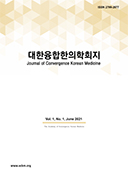 ISSN : 2799-2977
ISSN : 2799-2977
Hemodynamic effects of Chunwangbosim-dan - A 3-dimensional radial pulse tonometry device study

YoungSang KUN (DAEYOMEDI Co., Ltd.)
Tae Hun Ku (OkChundang Co., Ltd.)
Gyeung Cheul KIM (Dongeui University Korean Medicine department)

Abstract
Objectives: This study was aimed to evaluate the hemodynamic feasibility using pulse parameters as a way to establish safe dose guidelines for Chunwangbosim-dan, and to provide a foundation for developing evidence-based guidelines for clinical use. Methods: Forty-one volunteers were recruited to participate in a study examining the changes in pulse wave characteristics following the ingestion of Chunwangbosim-dan, over a period of 2 weeks, and pulse wave measurements were taken before and after the administration. Pulse wave parameters were measured in this study using a 3-dimensional radial pulse tonometry device(DMP-Lifeplus). In addition, questionnaire, blood pressure, temperature, and body composition were also measured as secondary measures. Results: Fifteen minutes after administration of Chunwangbosim-dan, the non-adverse event group(non-AE) exhibited a statistically significant increase in several power and pressure-related parameters, including h1, h3, h4, h5, SA, PA and PW, while the adverse event group(AE) showed a trend of decreasing stroke volume and increasing Systemic Vascular Resistance Index(SVRI) and applied pressure. After 2 weeks of administration, non-adverse event group(non-AE) exhibited significant changes in standard deviation of pulse rate and HRV_LH ratio. Notably, there are significant differences between AE group and non-AE group in h4/h1, w/t, applied pressure, SV and pulse rate. Conclusion: These findings suggest that pulse parameters may be a useful way to establish safe dosing guidelines for Chunwangbosim-dan. Further research is needed to confirm these results and to develop evidence-based guidelines for clinical use.
- keywords
- Chunwangbosim-dan, Cardiovascular disease, 3-D Radial Pulse Tonometry Device, Hemodynamic
- Downloaded
- Viewed
- 0KCI Citations
- 0WOS Citations

